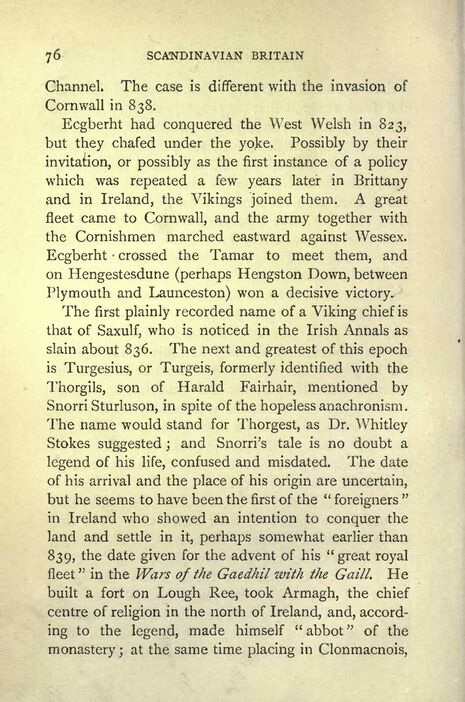
Full resolution (JPEG) - On this page / på denna sida - Scandinavian Britain - I. The Earlies Raids

<< prev. page << föreg. sida << >> nästa sida >> next page >>
Below is the raw OCR text
from the above scanned image.
Do you see an error? Proofread the page now!
Här nedan syns maskintolkade texten från faksimilbilden ovan.
Ser du något fel? Korrekturläs sidan nu!
This page has been proofread at least once.
(diff)
(history)
Denna sida har korrekturlästs minst en gång.
(skillnad)
(historik)
Channel, The case is different with the invasion of
Cornwall in 838.
Ecgberht had conquered the West Welsh in 823,
but they chafed under the yoke. Possibly by their
invitation, or possibly as the first instance of a policy
which was repeated a few years later in Brittany
and in Ireland, the Vikings joined them. A great
fleet came to Cornwall, and the army together with
the Cornishmen marched eastward against Wessex.
Ecgberht crossed the Tamar to meet them, and
on Hengestesdune (perhaps Hengston Down, between
Plymouth and Launceston) won a decisive victory.
The first plainly recorded name of a Viking chief is
that of Saxulf, who is noticed in the Irish Annals as
slain about 836. The next and greatest of this epoch
is Turgesius, or Turgeis, formerly identified with the
Thorgils, son of Harald Fairhair, mentioned by
Snorri Sturluson, in spite of the hopeless anachronism.
The name would stand for Thorgest, as Dr. Whitley
Stokes suggested ; and Snorri’s tale is no doubt a
legend of his life, confused and misdated. The date
of his arrival and the place of his origin are uncertain,
but he seems to have been the first of the "foreigners"
in Ireland who showed an intention to conquer the
land and settle in it, perhaps somewhat earlier than
839, the date given for the advent of his "great royal
fleet" in the Wars of the Gaedhil with the Gaill. He
built a fort on Lough Ree, took Armagh, the chief
centre of religion in the north of Ireland, and, according
to the legend, made himself "abbot" of the
monastery ; at the same time placing in Clonmacnois,
<< prev. page << föreg. sida << >> nästa sida >> next page >>